Topic 6: Misc. Questions
Note: This question is part of a series of questions that present the same scenario.
Each question in the series contains a unique solution that might meet the stated
goals. Some question sets might have more than one correct solution, while others
might not have a correct solution.
After you answer a question in this section, you will NOT be able to return to it. As a
result, these questions will not appear in the review screen.
You have two Azure SQL Database servers named Server1 and Server2. Each server
contains an Azure SQL database named Database1.
You need to restore Database1 from Server1 to Server2. The solution must replace the
existing Database1 on Server2.
Solution: You restore Database1 from Server1 to the Server2 by using the RESTORE
Transact-SQL command and the REPLACE option.
Does this meet the goal?
A. Yes
B. No
Explanation:
The REPLACE option overrides several important safety checks that restore normally
performs. The overridden checks are as follows:
Restoring over an existing database with a backup taken of another database.
With the REPLACE option, restore allows you to overwrite an existing database with
whatever database is in the backup set, even if the specified database name differs from
the database name recorded in the backup set. This can result in accidentally overwriting a
database by a different database.
Reference:
https://docs.microsoft.com/en-us/sql/t-sql/statements/restore-statements-transact-sql
You have an Azure SQL Database managed instance named SQLMI1. A Microsoft SQL
Server Agent job runs
on SQLMI1.
You need to ensure that an automatic email notification is sent once the job completes
What should you include in the solution?
A. From SQL Server Configuration Manager (SSMS), enable SQL Server Agent
B. From SQL Server Management Studio (SSMS), run sp_set_sqlagent_properties
C. From SQL Server Management Studio (SSMS), create a Database Mail profile
D. From the Azure portal, create an Azure Monitor action group that has an Email/SMS/Push/Voice action
You have an Azure SQL Database managed instance named sqldbmi1 that contains a
database name Sales
You need to initiate a backup of Sales.
How should you complete the Transact-SQL statement? To answer, select the appropriate
options in the answer area.
NOTE: Each correct selection is worth one point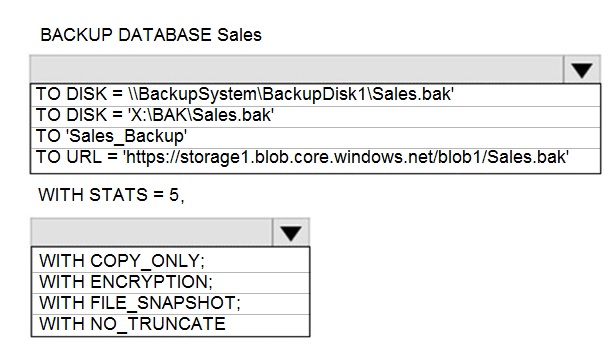
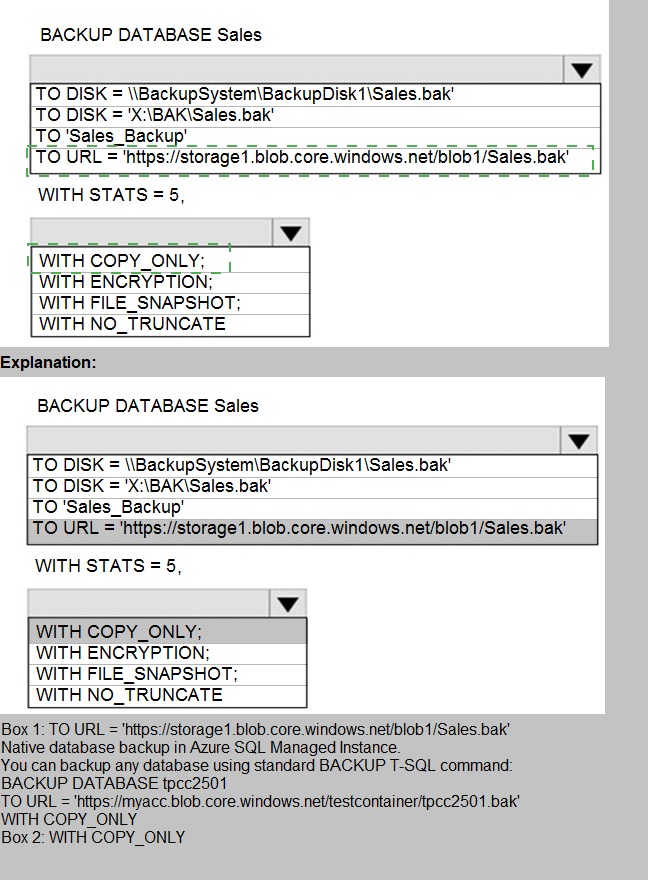
You have an Azure SQL database.
You discover that the plan cache is full of compiled plans that were used only once.
You run the select * from sys.database_scoped_configurations Transact-SQL command
and receive the results shown in the following table You need relieve the memory pressure.
You need relieve the memory pressure.
What should you configure?
A. LEGACY_CARDINALITY_ESTIMATION
B. QUERY_OPTIMIZER_HOTFIXES
C. OPTIMIZE_FOR_AD_HOC_WORKLOADS
D. ACCELERATED_PLAN_FORCING
Explanation:
OPTIMIZE_FOR_AD_HOC_WORKLOADS = { ON | OFF }
Enables or disables a compiled plan stub to be stored in cache when a batch is compiled
for the first time. The default is OFF. Once the database scoped configuration
OPTIMIZE_FOR_AD_HOC_WORKLOADS is enabled for a database, a compiled plan stub
will be stored in cache when a batch is compiled for the first time. Plan stubs have a
smaller memory footprint compared to the size of the full compiled plan.
Reference:
https://docs.microsoft.com/en-us/sql/t-sql/statements/alter-database-scoped-configurationtransact-
sql
You are planning disaster recovery for the failover group of an Azure SQL Database
managed instance.
Your company’s SLA requires that the database in the failover group become available as
quickly as possible if a major outage occurs.
You set the Read/Write failover policy to Automatic.
What are two results of the configuration? Each correct answer presents a complete
solution.
NOTE: Each correct selection is worth one point.
A. In the event of a datacenter or Azure regional outage, the databases will fail over automatically.
B. In the event of an outage, the databases in the primary instance will fail over immediately.
C. In the event of an outage, you can selectively fail over individual databases.
D. In the event of an outage, you can set a different grace period to fail over each database.
E. In the event of an outage, the minimum delay for the databases to fail over in the primary instance will be one hour.
Explanation:
A: Auto-failover groups allow you to manage replication and failover of a group of
databases on a server or all
databases in a managed instance to another region.
E: Because verification of the scale of the outage and how quickly it can be mitigated
involves human actions
by the operations team, the grace period cannot be set below one hour. This limitation
applies to all databases
in the failover group regardless of their data synchronization state.
Reference:
https://docs.microsoft.com/en-us/azure/azure-sql/database/auto-failover-group-overview
You are building a database backup solution for a SQL Server database hosted on an
Azure virtual machine.
In the event of an Azure regional outage, you need to be able to restore the database
backups. The solution must minimize costs.
Which type of storage accounts should you use for the backups?
A. locally-redundant storage (LRS)
B. read-access geo-redundant storage (RA-GRS)
C. zone-redundant storage (ZRS)
D. geo-redundant storage
Explanation:
Geo-redundant storage (with GRS or GZRS) replicates your data to another physical
location in the secondary region to protect against regional outages. However, that data is
available to be read only if the customer or Microsoft initiates a failover from the primary to
secondary region. When you enable read access to the secondary region, your data is
available to be read if the primary region becomes unavailable. For read access to the
secondary region, enable read-access geo-redundant storage (RA-GRS) or read-access
geo-zone-redundant storage (RA-GZRS).
Reference:
https://docs.microsoft.com/en-us/azure/storage/common/storage-redundancy
You have an Azure SQL database that contains a table named Customer. Customer has
the columns shown in the following table.
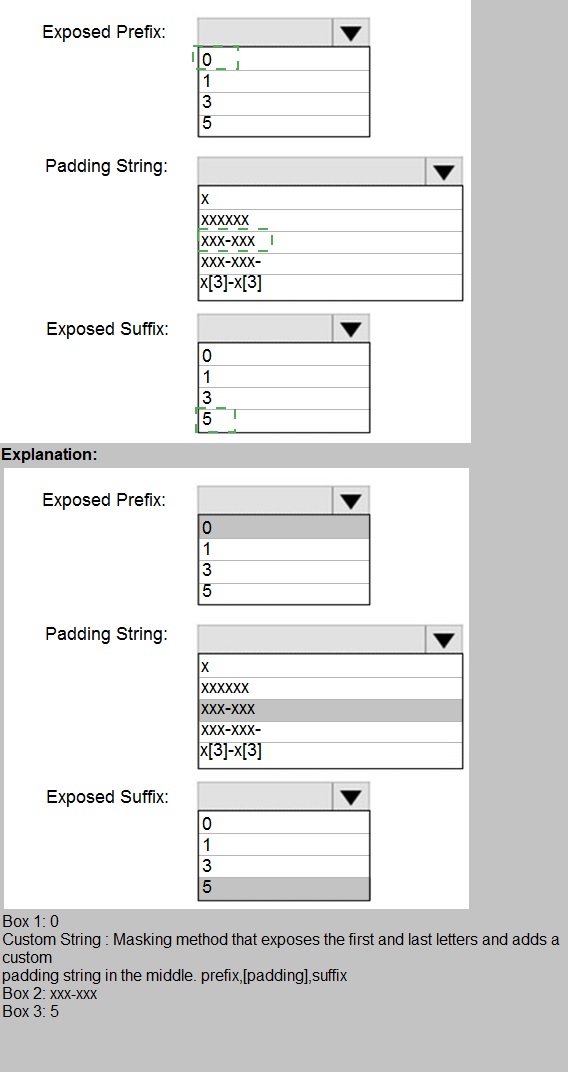
You have a Microsoft SQL Server database named DB1 that contains a table named
Table1.
The database role membership for a user named User1 is shown in the following exhibit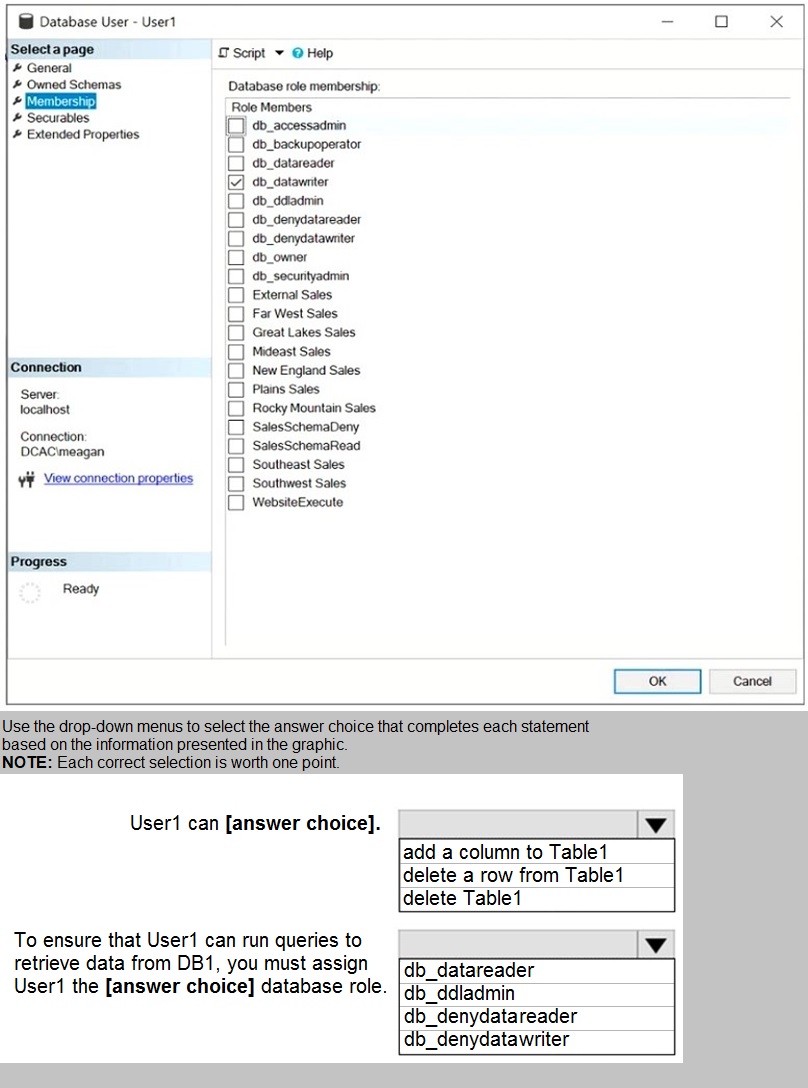

You have a resource group named App1Dev that contains an Azure SQL Database server
named DevServer1. DevServer1 contains an Azure SQL database named DB1. The
schema and permissions for DB1 are saved in a Microsoft SQL Server Data Tools (SSDT)
database project
You need to populate a new resource group named App1Test with the DB1 database and
an Azure SQL Server named TestServer1. The resources in App1Test must have the same
configurations as the resources in App1Dev.
Which four actions should you perform in sequence? To answer, move the appropriate
actions from the list of actions to the answer area and arrange them in the correct order.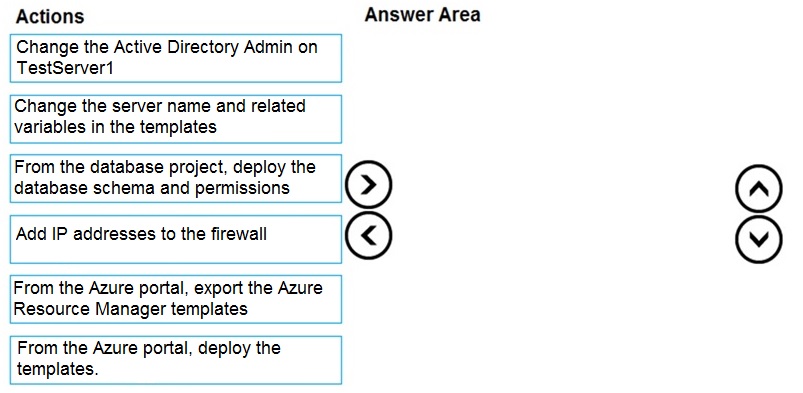

Note: This question is part of a series of questions that present the same scenario.
Each question in the series contains a unique solution that might meet the stated
goals. Some question sets might have more than one correct solution, while others
might not have a correct solution.
After you answer a question in this section, you will NOT be able to return to it. As a
result, these questions will not appear in the review screen.
You have an Azure SQL database named Sales.
You need to implement disaster recovery for Sales to meet the following requirements:
During normal operations, provide at least two readable copies of Sales.
Ensure that Sales remains available if a datacenter fails.
Solution: You deploy an Azure SQL database that uses the General Purpose service tier
and failover groups.
Does this meet the goal?
A. Yes
B. No
Explanation:
Instead deploy an Azure SQL database that uses the Business Critical service tier and
Availability Zones.
Note: Premium and Business Critical service tiers leverage the Premium availability model,
which integrates compute resources (sqlservr.exe process) and storage (locally attached
SSD) on a single node. High availability is achieved by replicating both compute and
storage to additional nodes creating a three to four-node cluster.
By default, the cluster of nodes for the premium availability model is created in the same
datacenter. With the introduction of Azure Availability Zones, SQL Database can place
different replicas of the Business Critical database to different availability zones in the
same region. To eliminate a single point of failure, the control ring is also duplicated across
multiple zones as three gateway rings (GW).
Reference:
https://docs.microsoft.com/en-us/azure/azure-sql/database/high-availability-sla
You have an Azure SQL Database server named sqlsrv1 that hosts 10 Azure SQL
databases.
The databases perform slower than expected.
You need to identify whether the performance issue relates to the use of tempdb on
sqlsrv1.
What should you do?
A. Run Query Store-based queries
B. Review information provided by SQL Server Profiler-based traces
C. Review information provided by Query Performance Insight
D. Run dynamic management view-based queries
Explanation:
The diagnostics log outputs tempDB contention details. You can use the information as the
starting point for troubleshooting.
You can use the Intelligent Insights performance diagnostics log of Azure SQL Database to
troubleshoot performance issues.
Reference:
https://docs.microsoft.com/en-us/azure/azure-sql/database/intelligent-insights-troubleshootperformance#
tempdb-contention
https://docs.microsoft.com/en-us/azure/azure-sql/database/intelligent-insights-usediagnostics-
log
Note: This question is part of a series of questions that present the same scenario.
Each question in the series contains a unique solution that might meet the stated
goals. Some question sets might have more than one correct solution, while others
might not have a correct solution.
After you answer a question in this section, you will NOT be able to return to it. As a
result, these questions will not appear in the review screen.
You have two Azure SQL Database servers named Server1 and Server2. Each server
contains an Azure SQL database named Database1.
You need to restore Database1 from Server1 to Server2. The solution must replace the
existing Database1 on Server2.
Solution: From the Azure portal, you delete Database1 from Server2, and then you create a
new database on Server2 by using the backup of Database1 from Server1.
Does this meet the goal?
A. Yes
B. No
Explanation:
Instead restore Database1 from Server1 to the Server2 by using the RESTORE Transact-
SQL command and the REPLACE option.
Note: REPLACE should be used rarely and only after careful consideration. Restore
normally prevents accidentally overwriting a database with a different database. If the
database specified in a RESTORE statement already exists on the current server and the
specified database family GUID differs from the database family GUID recorded in the
backup set, the database is not restored. This is an important safeguard.
Reference:
https://docs.microsoft.com/en-us/sql/t-sql/statements/restore-statements-transact-sql
| Page 3 out of 28 Pages |
| Previous |